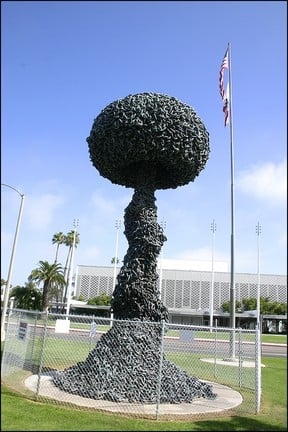
CIVIC CENTER — The Chain Reaction sculpture has become the focal point of public attention once again after two decades as a relative wallflower as city staff recommends removing it from Santa Monica’s public art collection.
The Arts Commission and its Public Art Committee will have a special joint meeting Wednesday to discuss the fate of the iconic Chain Reaction sculpture, a piece designed by three-time Pulitzer Prize winning cartoonist Paul Conrad that has fallen into disrepair over its 20-year tenure in Santa Monica’s Civic Center.
It would take between $227,372 and $423,172 to repair and conserve the piece, whereas removal would cost only $20,000, according to a staff report.
The fiberglass shell and copper chain links were tested and came up mostly positive, but the internal steel frame revealed corrosion and rust, and the anchor bolts attaching the sculpture to its foundation were weak, according to the report.
More tests would need to be done to determine the extent of damage that Chain Reaction has sustained over the years, tests which would be invasive and further damage the work.
A key factor in the staff recommendation to remove the piece is that even after committing hundreds of thousands of dollars to its repair, no one could guarantee the longevity of the piece, said Jessica Cusick, cultural affairs manager for City Hall.
The core of the sculpture is made of fiberglass, and engineers hired to examine the piece have been unable to determine how long the material will last if it’s left to weather the elements.
“If we simply repair the work, we’re really just handing the problem down another 10 or 15 years, or however long the viability of the fiberglass is,” Cusick said.
Furthermore, even the lowest cost projection to restore the sculpture is more than double the amount set aside in previous years to rehab four other public art pieces in the city.
“Two hundred to $400,000 could conserve most of the works in the collection,” Cusick said.
Activist Jerry Rubin led a campaign to preserve the piece, gathering signatures to show public support for the artwork.
“I certainly feel that Santa Monica should go the extra mile to try to do what they can to preserve that and keep it there,” Rubin said.
The piece, which depicts a mushroom cloud to symbolize the effects of nuclear weapons, is particularly important in a world where nuclear power and weapons have come to the fore, Rubin said.
According to the Bulletin of Atomic Scientists, attention has concentrated on Iran and its pursuit of civilian nuclear power, but the International Atomic Energy Agency estimates that another 20 to 30 countries possess the capability to pursue the bomb.
Conrad first offered the piece to City Hall in 1988. It took two years for the City Council to approve it, and it squeaked by with four council members in favor and three against, said former Mayor Judy Abdo who participated in the vote.
At the time, public art was a burgeoning field, and city staff was figuring out how best to approach and curate the collections. As a result, procedures which are now old hat, like getting building permits for the sculpture, were not followed.
Similarly, the kinds of materials used to build might not pass muster today, when the municipal process subjects art to a long approval process that examines how well the materials used will age.
The sculpture is part of a growing trend of older public art that is now falling into disrepair against a backdrop of shrinking budgets, Cusick said.
“Chain Reaction is typical of a number of issues that will come to light with works built with materials such as fiberglass, acrylic resin, and other materials used early on that are not necessarily as durable as traditional materials,” Cusick said.
The matter will go up before the joint Arts Commission and Public Art Committee on Wednesday night. After that, it will head to the City Council in March.
It doesn’t leave Rubin with a lot of hope.
“I don’t know if there’s anyone that will champion this on the City Council or the Arts Commission or city staff,” Rubin said. “What are we supposed to do? I’m not going to chain myself to it.”
ashley@www.smdp.com









